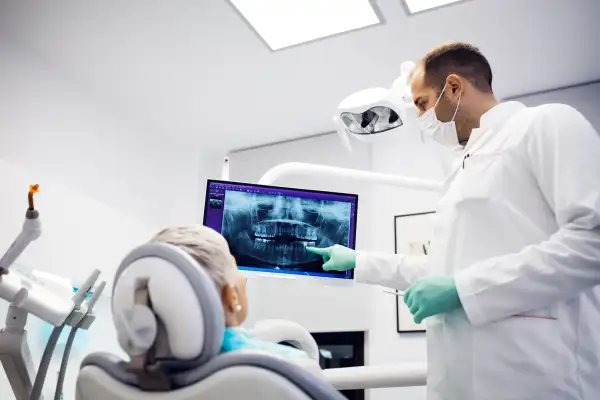Traditional Medicare Doesn't Pay For Dental Care. Here's How to Get Coverage

Traditional Medicare doesn’t pay for dental work, so to get coverage you have to buy a stand-alone plan or enroll in one of the Medicare Advantage plans that offer some dental benefits. Yet most of this coverage is basic and leaves people underinsured against this major expense, according to a new study.
Just over a third of Medicare beneficiaries are enrolled in Medicare Advantage, according to the Kaiser Family Foundation. That’s 22 million people, and if you’re one of them, now’s a great time to examine your coverage. The Medicare Advantage Open Enrollment Period runs through March 31, and during this time beneficiaries in Medicare Advantage can switch to a new Medicare Advantage plan or leave the program altogether and enroll in traditional Medicare. Beneficiaries currently in traditional Medicare can’t change their coverage during this window. (The difference between Medicare Advantage, also known as Part C, and traditional Medicare is that the former is managed by private companies that contract with the federal government to provide Parts A and B, while the latter is administered directly by the government.)
Sixty-two percent of Medicare Advantage consumers were in plans that included a dental benefit in 2016, according to a new study in the journal Health Affairs. By comparison, just 21% of beneficiaries in traditional Medicare had bought a stand-alone dental plan, the study found.
The premium for stand-alone dental coverage often runs in the vicinity of $30 a month. By contrast, many Medicare Advantage plans have $0 premiums, so you get some dental care for no extra cost. This benefit “gets people in the door” to see the dentist, says Amber Willink, associate professor of health policy at the University of Sydney in Australia and one of the co-authors of the Health Affairs study, along with researchers at Johns Hopkins University.
But once they get in the door, most patients find that dental coverage doesn’t put that much of a dent in their bills. In 2016, Medicare beneficiaries with dental coverage averaged $894 in out-of-pocket spending, compared to $928 for those without, according to the study.
“The coverage is very minimal,” says Dr. Margaret Gingrich, DDS, president of the Michigan Dental Association and a dentist with a private practice in Big Rapids, Mich.
For example, many dental plans will cover a basic cleaning or two each year. That sounds good, until you consider that many older adults aren't even candidates for a basic cleaning, Gingrich says. Over half of adults age 60 and over have a condition, such as bone loss or gum disease, that requires a more specialized cleaning, she notes. What's more, many patients haven't been to the dentist in years, and when they finally get coverage and come to her office, they need a more intensive cleaning. Gingrich has patients puzzled why they can’t use their dental benefits, and she has to explain that their plan doesn’t cover the level of services they need.
Mary Johnson recently experienced the limitations of dental coverage. A Social Security and Medicare policy analyst at The Senior Citizens League, Johnson is on traditional Medicare and bought a stand-alone dental plan online from one of the few providers in her rural Virginia area.
She has gum disease, and the uncovered cost for her periodontal surgery and follow up was $5,000. Last year, she needed implant surgery, and the uncovered cost for that was $3,500, Johnson says. (The replacement tooth itself was covered for $1,250, she notes.) Even with her insurance, “the largest out-of-pocket cost remained uncovered,” Johnson says.
So what can you do, given these limitations? If you decide against dental coverage, look into low-cost treatment at a local dental school or clinic, or ask your dentist about cash and upfront discounts and payment plans. While cost can be a big barrier, it’s important not to neglect your oral health. “I don’t think people appreciate the extent to which oral health is a part of general health, and it can wreak havoc if you don’t take care of it,” Willink says. In just a couple examples, poor oral health can exacerbate cardiovascular and respiratory diseases.
Know What You're Buying
There are three factors to consider, says Andrew Shea, vice president of eHealthMedicare.com:
1. What does the plan cover? Understand the terminology used — for example, what is a “basic” cleaning, and what kind of x-rays does the plan include? Many don’t cover full mouth x-rays, Dr. Gingrich says.
2. How does the plan cover services? Some plans have elimination periods for major procedures. So patients might buy a policy because they know they need a root canal, only to discover they need to wait six months or even two years on the policy before they can get the procedure. Understand your choice of dentists, too.
3. How much does the plan cost? Look beyond the premium to any co-payments and co-insurance (the percentage of the bill that you owe) that you might be responsible for. Also, know your plan’s annual coverage limit. Many plans cap their coverage at anywhere between $1,000 and $2,500 a year.
“Having some kind of coverage is certainly better than nothing,” Shea says. “But this is not an all-you-can-eat buffet.”
